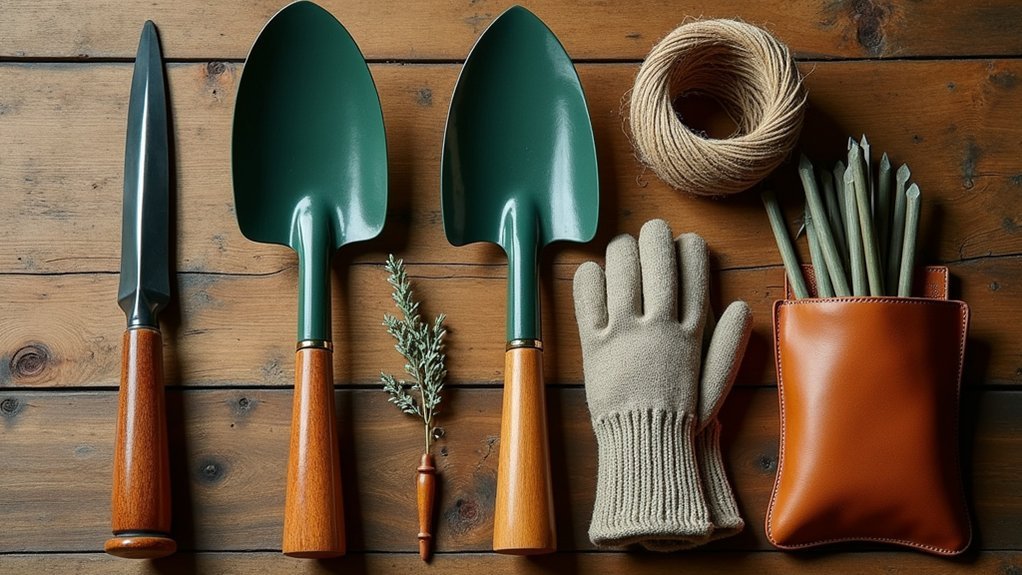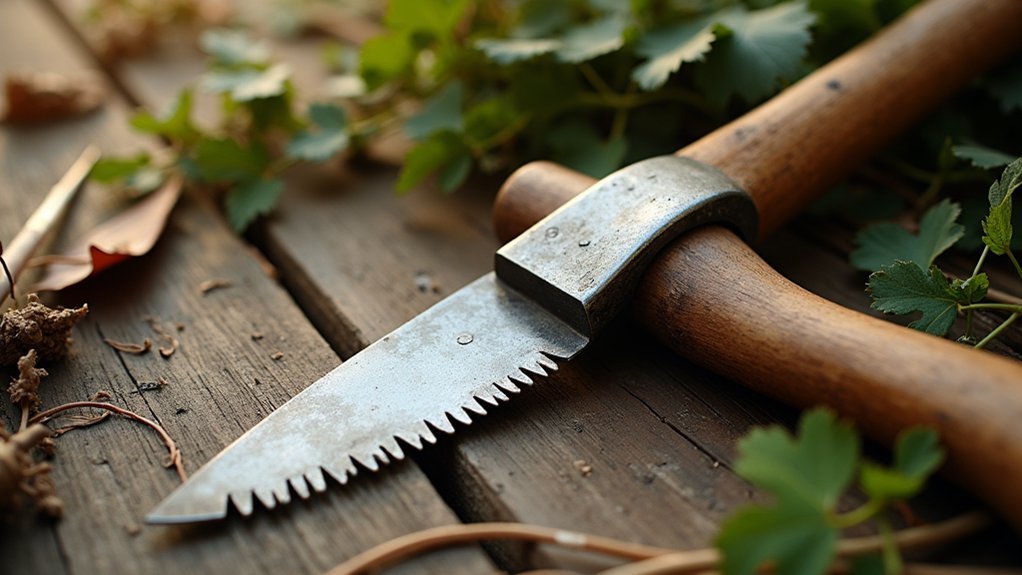For hedgerow laying, you’ll need a well-maintained billhook as your primary tool, alongside a quality handsaw for thicker stems. Essential equipment includes a beadle or mallet for driving stakes, and an axe for larger cuts. Source traditional hazel or ash stakes (40-50mm thick) and flexible binders (under 25mm) during dormancy. Vintage tools offer superior comfort and durability compared to modern alternatives. The following guide unpacks everything you need to begin your hedgelaying journey.
Essential Hedgerow Laying Tools for New Craftspeople

When starting on the ancient craft of hedgelaying, you’ll need several purpose-specific tools to properly cut, shape, and secure your living fence. The billhook is indispensable for cutting and shaping pleachers, with Yorkshire and Devon varieties offering regional advantages.
For thicker stems, invest in a quality hand saw—the Japanese-designed Silky Fox provides excellent precision.
You’ll drive hazel stakes using a beadle, though a blacksmith’s hammer works well as an alternative. Flexible hazel rods will bind your hedge securely.
Don’t overlook vintage tools, renowned for superior craftsmanship, but maintain them through regular cleaning, sharpening, and oiling.
Always prioritize safety gear, particularly gloves and helmets, to protect yourself while wielding sharp implements. Proper tool selection and maintenance will set you up for hedgelaying success.
The Billhook: Selecting Your Primary Cutting Tool
Regional variations of billhooks offer you distinct advantages based on your local hedging style, with Yorkshire models featuring a straighter edge while Kentish designs provide a more pronounced curve for drawing cuts.
You’ll find regular care of your billhook essential, particularly maintaining a sharp edge through proper honing techniques and occasional professional regrinding.
Your investment in understanding these regional differences and mastering maintenance routines will greatly extend your tool’s lifespan and enhance your hedgelaying efficiency.
Regional Billhook Variations
Though often overlooked by beginners, the distinct regional variations of billhooks can greatly impact your hedgelaying efficiency and results. Each design evolved to complement local hedgelaying styles and vegetation challenges.
The Yorkshire Billhook offers a straight or slightly curved blade that excels at general cutting tasks, making it a sturdy all-purpose tool.
For dense hedgerows, consider the Devon Billhook with its curved blade and shorter handle for improved maneuverability.
The Kentish variation provides enhanced leverage through its pronounced curve, ideal for tougher stems.
Need versatility? The Hampshire Billhook features a double-edged blade for both slicing and splitting.
For lighter work like coppicing or vine pruning, Continental Billhooks with their exaggerated curves offer excellent precision.
Matching your billhook to your specific regional hedgelaying technique will greatly improve your results.
Care and Sharpening
Maintaining your billhook in peak condition determines the success of your hedgelaying projects. Regular sharpening guarantees the clean cuts essential for proper hedge regeneration. Use a sharpening stone or file to maintain the blade’s edge, working with smooth, consistent strokes along the cutting surface.
After each use, clean your billhook thoroughly to remove sap and debris that can damage the metal. Simply wipe down the blade with a cloth and apply a light coating of oil to prevent rust.
Don’t ignore the handle—repair or replace it when damaged to maintain safety and tool longevity.
Different billhooks require specific maintenance approaches. The Yorkshire variant needs general care, while the Kentish billhook’s pronounced curve demands careful sharpening to preserve its leveraging capabilities for tackling tougher stems in your hedgelaying work.
Axes and Saws: When and How to Use Them

When tackling more substantial stems and branches in hedgerow laying, you’ll need to move beyond the billhook to axes and saws. These tools excel at making precise cuts through thicker stems that would challenge a billhook.
| Tool | Best For | Maintenance |
|---|---|---|
| Felling Axe | Large trees and branches | Regular sharpening |
| Side Axe | Precise cutting on thick stems | Oil after use |
| Japanese Hand Saw | Clean cuts on medium stems | Keep teeth clean |
| Silky Fox | Efficient cutting of larger wood | Store in sheath |
| Billhook | Comparison: best for smaller work | Sharpen frequently |
Choose your tool based on the task at hand. For hedgelaying success, maintain a sharp felling axe for heavy work, while keeping a quality hand saw like the Silky Fox ready for cleaner finish cuts on substantial stems.
Stakes and Binders: Materials and Preparation
You’ll need to choose between traditional hazel or ash stakes (40-50mm thick) and modern alternatives, ensuring proper material selection impacts your hedge’s longevity.
For best results, source your materials during the dormant season (October-March) and allow them to season properly before use.
When selecting binders, look for straight, flexible hazel rods under 25mm thick, avoiding knotty specimens that won’t weave effectively around your carefully prepared 1.2-1.5 meter stakes.
Traditional Materials Versus Modern
As hedgelaying practices evolve, the choice between traditional and modern materials for stakes and binders presents significant considerations for craftspeople.
You’ll find traditional materials offer ecological compatibility that modern alternatives often lack. Hardwoods like hazel and ash provide durable, flexible stakes that work harmoniously with the hedge’s natural growth cycle, while synthetic options may disrupt the ecosystem.
- Natural stakes from local hardwoods integrate seamlessly with the hedgerow, breaking down gradually as the hedge establishes itself.
- Traditional hazel binders flex and weave naturally, supporting new growth without constraining it.
- Modern alternatives offer convenience and sometimes longevity, but sacrifice the sustainable, biodegradable qualities that maintain hedgerow health.
While modern materials might save time initially, traditional options ultimately create more resilient, ecologically sound hedgerows that fulfill their historic purpose.
Proper Seasoning Techniques
The selection of appropriate materials represents only the first step in creating lasting hedgerows; proper seasoning transforms raw wood into reliable tools that stand the test of time.
You’ll need to guarantee your stakes are sturdy enough by harvesting hazel or ash wood, then implementing proper seasoning techniques. Air-drying is essential—store your materials in a cool, dry place for six months to a year to reduce moisture content and prevent mold.
For the best results, harvest flexible hazel rods for binders in late winter before sap rises, maximizing their pliability for weaving.
Once seasoned, stakes should be sharpened to a point using a billhook or axe, creating clean entries into the soil without splitting the wood. This preparation process guarantees your hedgerow materials remain resilient throughout their service life.
Size and Selection Guidelines
Selecting the right dimensions for your hedgerow materials directly impacts the strength and longevity of your finished structure. For stakes, choose hazel or ash wood with 40-50mm thickness to guarantee they’re durable enough to support your hedge. Cut these to 1.2-1.5 meters in length and sharpen one end for easier ground insertion.
Your binders should be more flexible, using hazel rods no thicker than 25mm to facilitate proper weaving without damaging the laid stems.
- Collect both stakes and binders during winter months (October-March) when the wood has ideal flexibility.
- Sharpen stake ends to a precise point, creating clean entry into soil for maximum stability.
- Select straight, knot-free sections for binders to guarantee they’ll bend without breaking when weaving.
The Beadle and Mallet: Driving Tools for Stability
Stability forms the backbone of any well-crafted hedgerow, achieved primarily through properly driven stakes and the right tools for the job.
The traditional beadle is your essential companion for driving stakes into the ground without damaging them. This wooden tool offers superior ergonomic benefits, absorbing shock better than modern alternatives while providing comfort during repetitive striking.
Nothing matches the traditional beadle for stake-driving efficiency—its wooden construction absorbs shock while sparing your joints during extended hedgerow work.
If you don’t have a beadle, a blacksmith’s hammer made from hardened steel offers a durable alternative.
For additional protection of your hazel or ash stakes, consider placing an off-cut of wood as a cap on top of the stake before striking. This simple technique preserves the integrity of your materials while ensuring the necessary stability for your hedgerow’s foundation.
Vintage vs. Modern Tools: Making the Right Choice

When considering the tools of your trade, you’ll face a meaningful choice between vintage and modern hedgelaying implements. Vintage tools offer superior craftsmanship and durability, with wooden handles providing ergonomic design that absorbs shock and reduces fatigue during long workdays.
- Heritage value – Vintage billhooks and axes connect you to centuries of hedgelaying tradition, enriching your craft experience beyond mere functionality.
- Maintenance investment – Regular cleaning and sharpening of vintage tools enhances their performance, making them a sustainable, long-term investment.
- Task-specific selection – Consider your regional hedgelaying style when choosing between vintage and modern tools, as each has strengths suited to particular techniques.
Remember that while modern tools offer material advancements, they often can’t match the comfort and character of well-maintained vintage implements.
Frequently Asked Questions
What Tools Are Needed for Hedge Laying?
You’ll need a billhook (Yorkshire, Devon, or Kentish style), hand saw (preferably Silky Fox), hand axe, beadle (or alternative), French loppers, and pruning saws. Don’t forget to maintain them regularly.
How to Lay a Hedge for Beginners?
Start by cutting lower branches, then make angled cuts near ground level. Lay stems at an upward angle in a criss-cross pattern. Install stakes every 50cm and bind with hazel rods. Trim regularly to maintain shape.
What Is the Best Billhook for Hedge Laying?
For hedge laying, you’ll find the Yorkshire billhook most versatile for beginners. It’s got a straight blade that’s forgiving while you’re learning. If you’re tackling thicker stems, consider a Devon billhook instead.
What Tools Are Used Mostly for Hedges?
For hedges, you’ll primarily use billhooks (like Yorkshire or Devon styles), hand saws (such as Silky Fox), beadles for stake-driving, axes for thicker stems, and pruning tools like loppers for side branches.
In Summary
You’ll find hedgerow laying both challenging and rewarding as you develop your skills. Start with quality tools that feel comfortable in your hands, and don’t hesitate to learn from experienced craftspeople. Whether you choose vintage or modern equipment, proper maintenance is essential. With practice and the right tools, you’ll soon create hedgerows that are both functional and beautiful, preserving this traditional countryside craft.





Leave a Reply